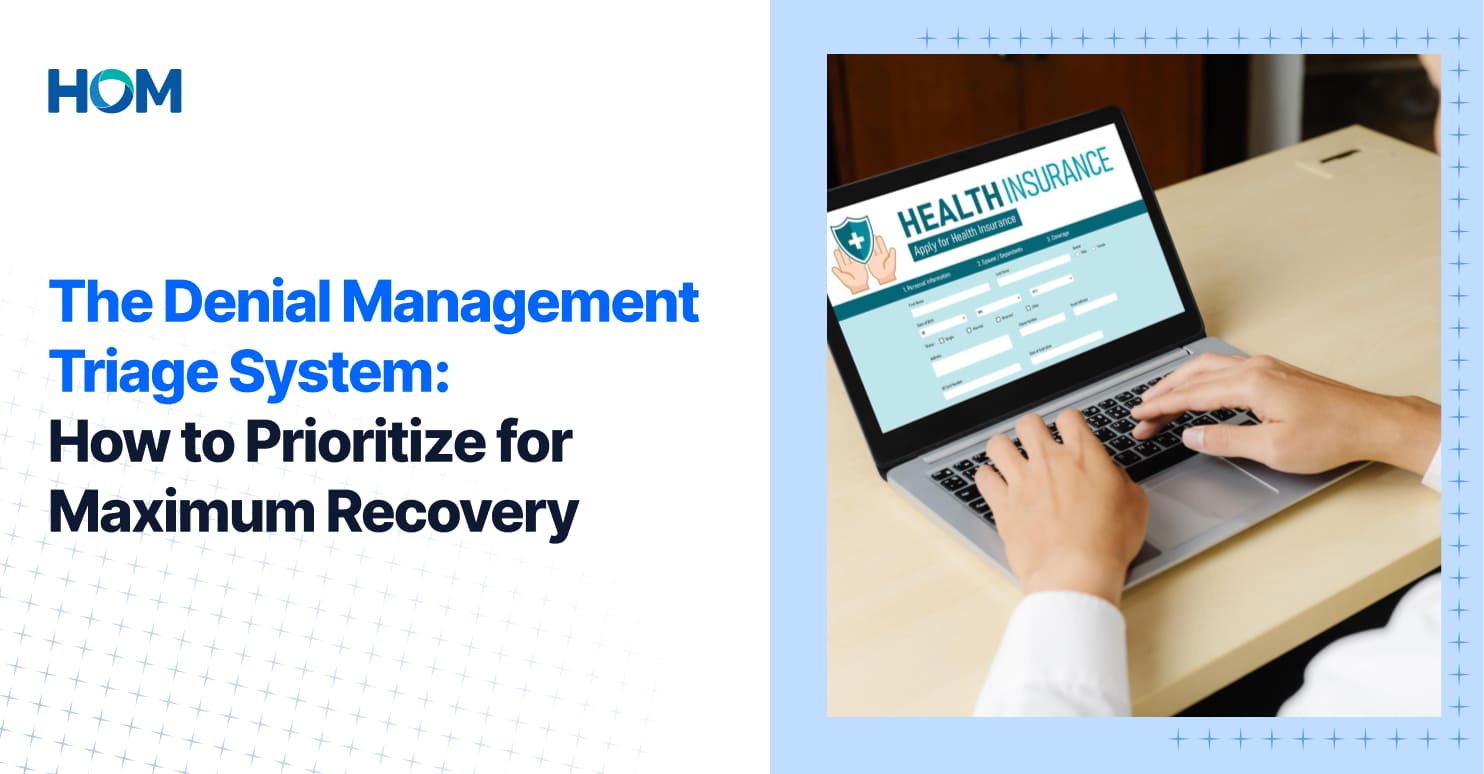
The cost burden for healthcare providers to secure reimbursements from insurers shows no signs of slowing down. A recent healthcare denial management survey shows that nearly 15% of submitted claims for reimbursement are initially rejected.
Each denied claim not just strains the finances but also increases the percentage of dissatisfied providers and/or patients as their billing problems go unresolved. Without a well-established and proven strategy for prioritizing denials, healthcare organizations may altogether forgo high-value claims while wasting their resources on low-value cases.
To address this and many other challenges, a denial management triage system provides a structured framework. The triage helps healthcare organizations strategically direct their team’s efforts toward revenue-generating denials and optimize resources simultaneously.
With 8+ years of experience, HOM has helped providers achieve up to 95% denial recovery and improve reimbursements by as much as 30% through AI-powered denial management services.
This blog provides a proven four-tier denial prioritization model, best triage implementation practices, and how HOM’s expertise and technology support maximum revenue recovery.
Understanding Poor Denial Prioritization: What’s at Stake?
In reality, the impact of ineffective denial management is much more profound than only the loss of revenue. When denials are handled reactively, without a structured triage system, it sets off a chain of financial and operational challenges:
- Cash flow is immediately affected as high-value claims go pending, while employees’ time is used on cases with little chance of recovery.
- Administrative costs increase as teams work extra hours on denials that may never generate positive results.
- Patients’ experience and trust in the healthcare provider are also damaged because of confusing billing problems and delayed resolutions.
This reactive approach creates a hard-to-break cycle. As denial volumes increase, employees feel overwhelmed, resolution times stretch, and recovery rates decline further. Without a well-defined prioritization process, management ends up spending their expert professionals on tasks that could be handled by juniors, leaving complex, high-value denials under-addressed.
The misallocation of resources not only slows operations but also directly reduces recovery and profitability.
How a Triage System Addresses Denial Management Challenges?
A denial management triage system works much like medical triage in emergency departments.
Instead of prioritizing patients, your revenue cycle management team prioritizes denials based on the likelihood of recovery. In well-planned triage frameworks, denials are categorized by claim value, type of payer, reason for denial, likelihood of recovery, and urgency. With clear evaluation criteria, your team can devote time and effort to the most critical cases without relying on biases or guesswork.
Prioritizing for Maximum Recovery: Four-Tier Denial Triage Framework
The following framework helps providers categorize and act on denials methodically:
Note: The dollar values and percentages in this framework are examples only. Your organization should customize these thresholds based on your average claim values, historical recovery rates, and operational costs.
Tier 1: High-Value, High-Recovery Priority
Addressing these denials first will help you protect cash flow. Target claims with a value exceeding $5000 and denial reasons with a recovery rate above 70%. Some examples of such reasons are missing documentation, coding errors, and minor authorization issues.
Your action strategy should be assigning these denials to your most experienced staff member. Set the target resolution within 2 to 7 days to minimize aging and maximize recovery chances. Track these denials closely with daily status updates.
Your recovery strategy should focus on rapidly submitting documentation, contacting the payer directly when necessary, and leveraging established payer relationships. HOM's fast denial resolution services can help organizations identify and address these high-priority denials within 48 hours, with proven denial recovery rates of up to 95%.
Tier 2: Moderate-Value, Moderate Recovery Probability
This tier consists of denials with a value between $1000 and $5000 and recovery probabilities ranging from 40% to 70%. These denials often involve clinical documentation improvement gaps, eligibility issues, minor coding corrections, or standard prioritization appeals. While not extremely urgent, they do have better recovery possibilities.
Assign these denials to mid-level staff who have received proper training and guidance. Set a target resolution of 7-14 days to maintain reasonable aging and work quality. Using standardized templates and procedures helps streamline the appeal process for common reasons for denials. Tracking patterns further helps identify opportunities for prevention at the front of the revenue cycle. HOM's clinical documentation improvement services are particularly valuable for resolving Tier 2 denials involving documentation gaps.
Tier 3: High-Value, Low-Recovery Probability
These denials have a significant monetary impact. They mostly exceed $5000 and have complicated clinical and coverage issues, which decrease their recovery probability. Their financial value justifies careful review. Examples include experimental treatment denials, medical necessity disputes, or appeals that have already failed several attempts.
For these denials, the best action strategy would be careful case-by-case evaluation by the most senior denial management specialists. Some cases may need legal consultation or escalation to special clinical expertise. Therefore, it is crucial to determine whether the potential recovery justifies the cost of pursuit.
Denial management teams must document a detailed rationale for pursuing these denials to inform future decision-making. Target 30-60 days for resolution. HOM's experienced denial management specialists can provide the senior-level expertise needed to evaluate these complex cases and determine optimal pursuit strategies.
Tier 4: Low-Value Claims
Denials under $1000 with low recovery probability or high processing cost fall under this tier. The economics often favor write-offs over pursuit, especially when the cost of skills required exceeds the estimated recovery value.
However, batch processes and automation may help identify denial patterns that can be used to prevent similar issues in the future. Setting pre-determined thresholds for automated write-offs based on age, value, and previous appeal attempts can improve outcomes. The recovery strategy for such denials should focus on cost control instead of maximum recovery.
This structured prioritization helps revenue cycle teams align their energy with financial recovery goals rather than administrative volume.
Best Implementation Strategy
To successfully implement a sustainable and scalable denial management triage system, organizations must use an approach that balances technology, processes, and an expert revenue cycle management team.
- Review at least six months of denial data to understand current patterns, recovery rates, and resource allocation to set realistic targets.
- Develop clear SOPs for each tier. This should cover assignment criteria, timeframes, documentation needed, expertise required, and steps for escalation.
- Monitor key metrics like tier-specific recovery rates, resolution times, and staff productivity through reporting systems that generate real-time data.
- Create excellent communication loops between denial management and upstream processes (registration, billing, CDI, medical coding, authorization) to prevent future denials.
- Establish a strong relationship with insurance companies to foster smoother and faster resolution and prevent disputes.
- Use the power of AI-assisted analysers to automate denial categorization based on claim value, reason, payer history, and recovery probability.
- Adopt a proactive approach to revenue cycle management that integrates claim processing, billing, and payment collection to ensure financial stability.
Key Takeaway
Denial management triage enables healthcare organizations and providers to concentrate on the right claim at the right time. Success can be derived by combining strategic prioritization with expert team execution and advanced technology.
Having served 300+ providers globally with certified professionals and data-driven analytics in 15+ medical specialties, HOM brings eight years of proven track record in customized denial management services. HOM’s comprehensive denial management services address all these implementation requirements, providing customizable triage rules, real-time dashboards, and seamless integration with existing RCM processes. Our 8 years of experience serving 300+ providers haves refined these best practices into a proven methodology.
To date, we have retrieved more than $100k from aged claims and achieved a 95% denial recovery rate to ensure no more than 12% of providers’ AR remains unsolved.
To know how HOM can help you recover the most from your denied claims, contact us now. You may also email your requirements to partnerships@homrcm.com.
Bring a change to your Healthcare Operations
A partnership with HOM gives you an inherent:
Connect with our experts for a quick analysis and possibilities.
















